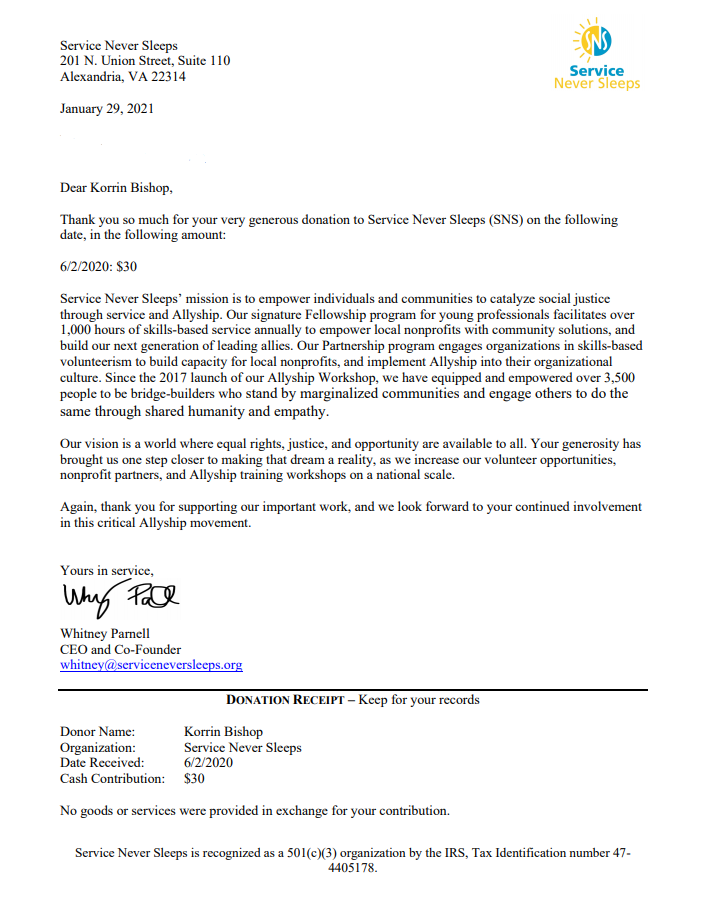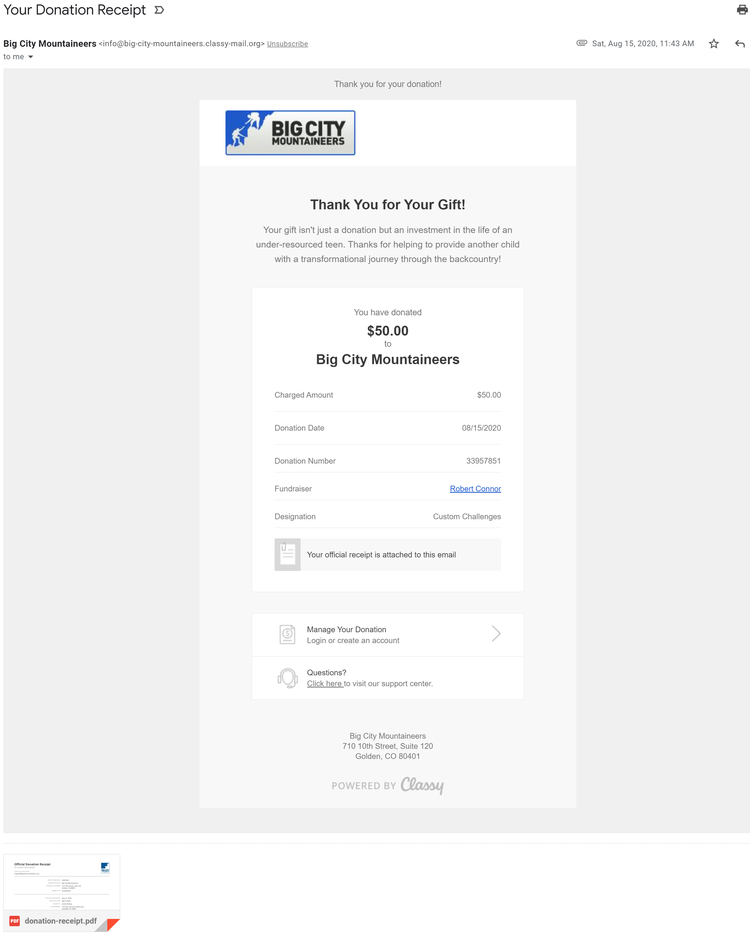How to Create Donation Receipts for Your Donors
Effective fundraising for nonprofits includes pursuing diverse funding streams, including grants, corporate sponsorships, and charity events. The most common form of fundraising, however, is obtaining gifts from individual donors.
Individual donors can give small gifts of just one dollar or ones that number in the tens of thousands. They can also provide in-kind donations -- also known as non-cash contributions -- such as furniture, food, or professional services. Donations from individuals provide needed support for a nonprofit’s work while building a community of support around the nonprofit’s mission.
If your nonprofit accepts individual donations, you’ll need to know when and how to create a nonprofit donation receipt for each donor’s tax filing purposes.
Overview: What is a donation receipt?
Donations made to a 501(c)(3) nonprofit organization may be used as a tax deduction on a donor’s federal tax return. However, for donors to claim this tax deduction, they need to maintain written documentation for any gifts valued at $250 or more.
Donors rely on nonprofits to send them a 501(c)(3) donation receipt for their records to prove to the Internal Revenue Service (IRS) that they made a charitable contribution that year.
When does the IRS require donation receipts?
Donation tax receipts are required for any contribution of $250 or more to a 501(c)(3) nonprofit. This includes both cash contributions, as well as noncash gifts with an estimated value of $250 or more.
Failure to meet this written disclosure policy can result in a $10 penalty from the IRS per contribution for the nonprofit, up to a maximum of $5,000 for each fundraising event or mailing.
Rules and regulations regarding donation receipts
The IRS outlines specific details that need to be included in donation receipts, as well as some exceptions and special rules for different donation scenarios. It’s always important to seek legal advice and review IRS regulations directly to inform your nonprofit’s operations. However, the basics of these requirements are summarized below:
- Required details: All donation receipts need to include the name of your organization, the amount of the donor’s cash contribution, and a description (but not a monetary value) of any non-cash contribution.
- Verification of no quid pro quo: If the donor received nothing in exchange for their contribution, then that needs to be stated on the donation receipt.
- Description of provided services: If your nonprofit provided goods or services in exchange for a donor’s contribution, then your donation receipt needs to provide a description of what those were.
- Verification of intangible religious benefit: If the goods or services your nonprofit provided in exchange for a donor’s contribution consisted solely of intangible religious benefits, such as admission to a religious ceremony or materials used within that ceremony, then that needs to be stated in your donation receipt. You do not have to detail those goods or services, but rather simply use the phrase “intangible religious benefits” to describe them.
- Disclosure of any quid pro quo contributions: If a donor receives goods or services beyond intangible benefits for their gift, then their contribution is only tax deductible up to the amount that exceeds the fair market value of what they received in exchange. For example, if they gave your nonprofit $100 in exchange for a concert ticket valued at $30, then the amount that may be eligible for tax deductions is $70. Your donation receipt needs to acknowledge the amount the donor contributed, a good-faith estimate of the fair market value of what they received in exchange for the contribution, and a note that, for federal income tax purposes, their contribution is only deductible less the value of what they received.
- Timely delivery: For a tax-deductible donation receipt to count as contemporaneous with a donor’s gift, the donor must receive written acknowledgment of the contribution by the date the donor files their federal income tax return for the year of the contribution or the due date of the return, whichever comes first.
How to create an IRS-compliant donation receipt
Your nonprofit accounting department can create IRS compliant donation receipts with a few simple steps.
1. Create a template on your nonprofit’s letterhead
Your donation receipt should look official, so create a template on your nonprofit’s letterhead. Include stock text with fill-in-the-blank spots for donor name, donation date, and amount and description of the contribution.
Below the specific donor information, include stock language to address any quid pro quo situations and make disclosures to the donor about how much of their donation may be tax-deductible.
Have your executive director or another executive-level official from your nonprofit sign each of the letters.

Having a donation receipt template ready to go on your nonprofit’s letterhead makes dropping in the specific donor information and getting them mailed quickly a breeze. Image source: Author
2. Run a list of donors from the year
Pull data from your customer relationship management (CRM) software or online fundraising platform on donations received during the timeframe for which you’d like to send donation receipts. This will give you the donor information and donation amounts and dates you’ll need to plop into your donation receipt template.
Some nonprofits will pull the data and send donation receipts once per year at the end of the year. However, you don’t have to wait until then to send them out. You can also choose a more frequent cadence of sending them monthly or quarterly.
Additionally, while the IRS only requires a donation letter for $250 or more, many nonprofits follow the best practice of sending out one for each gift, regardless of size. This results in fewer follow-up questions from donors and gives your nonprofit a chance to thank them again for their gifts.
3. Mail or email donation receipts to your supporters
The final step is simple. Once you’ve created a donation receipt letter, send it to the donor for their recordkeeping. Some nonprofits prefer the formality of mailing hard copies of donation receipts to their supporters. However, more and more are opting to email the receipts.
Emailing donation receipts makes the process quick and easy, especially if you’re using an online fundraising platform programmed to send them automatically. Some fundraising software options can be set up to email a thank you note along with a PDF of an official donation receipt attached to the email immediately following a supporter’s gift.
You can always make a note in your emails to supporters that you’re happy to mail a hard copy version upon request.

Many fundraising software platforms, such as Classy, provide an option to have donation receipts automatically emailed to donors following their gift. Image source: Author
3 best practices when writing donation receipts
After you’ve covered the basics required by the IRS, there are a few best practices you can follow to make the most out of your donation receipts and ensure they’re fully compliant.
1. Avoid promising tax deductions
A charitable donation receipt doesn’t promise anything to a donor in terms of how their tax return ends up. It’s simply provided for their own documentation of their charitable giving from that year. Since you don’t know each donor’s tax filing status, don’t tell them that their gift is tax-deductible. Rather, tell them that their contribution may be tax-deductible based on their situation.
You can also choose to simply state the contribution amount without getting into the nitty-gritty of tax details. Sometimes less is more. Here are two examples:
- Thanks so much for your cash gift of $175 to Save the World, which we received on March 15, 2020. No goods or services were provided in exchange for your contribution.
- Thank you for your cash contribution of $500 that the Stray Cat Emergency Fund received on January 3, 2021. In exchange for your contribution, we gave you a cat tree with an estimated fair market value of $55.
2. Remember to say thank you
Donation receipt letters may have some formal requirements, but they’re also an opportunity to thank your donors again. Save some space in your letter to share some quick notes on what your donors’ gifts have helped your nonprofit achieve. Remind them of your mission and thank them for being a part of it.
Taking time to thank your donors strengthens your relationships with them and makes it more likely that they’ll want to stay connected to your work and support you again.
3. Offer opportunities to support your work again
Recurring gifts from donors can be a critical piece of a nonprofit’s fund development. Use your donation receipts to offer opportunities for donors to engage with your work again. This could be telling them about an upcoming event you’re having, mentioning volunteer positions they may be interested in, or making an ask for them to donate again to your new initiative.
Since many of your donation receipts are likely being sent to first-time donors, use them as a chance to build your relationship with that individual and turn them into a recurring donor.
Meet IRS requirements and improve donor stewardship through your donation receipts
One of the inevitable tasks you’ll face when you start a nonprofit is meeting the recordkeeping and reporting requirements for your 501(c)(3) nonprofit status. Timely and complete donation receipts are one of these requirements. However, using best practices, you can turn this IRS requirement into an opportunity for donor stewardship.
Alert: our top-rated cash back card now has 0% intro APR until 2025
This credit card is not just good – it’s so exceptional that our experts use it personally. It features a lengthy 0% intro APR period, a cash back rate of up to 5%, and all somehow for no annual fee! Click here to read our full review for free and apply in just 2 minutes.
Our Research Expert
We're firm believers in the Golden Rule, which is why editorial opinions are ours alone and have not been previously reviewed, approved, or endorsed by included advertisers. The Ascent does not cover all offers on the market. Editorial content from The Ascent is separate from The Motley Fool editorial content and is created by a different analyst team.
Related Articles
View All Articles